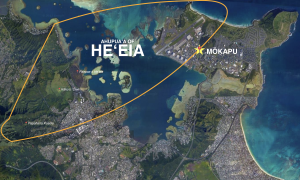Moʻolelo Monday
On the first Monday of the month a traditional or modern moʻolelo depicting the jculture, values, language or traditions of Hawaiʻi, will be shared through a virtual platform. These mo‘olelo promote literacy within the classroom and home, and encourage ʻohana to read and learn together. Moʻolelo are shared by staff and guest storytellers.
MOʻOKALALEO
In the 1820’s, Kauikeaouli, Kamehameha III was the catalyst for the rise of literacy in Hawaiʻi. He stated, “ ʻO Koʻu Aupuni, he Aupuni palapala koʻu. My kingdom shall be a kingdom of literacy”. Within our moʻokalaleo, we share a literacy component that extends our moʻolelo journey.
Kānehulihonua and Keakahulilani
In the time when the Earth was being formed, the gods counseled together on the eastern side of Oʻahu at Mōkapu, a peninsula within the ahupuaʻa of Heʻeia. It was here as Kamakau writes of a moʻolelo of the first humans created, Kānehulihonua and Keakahulilani.

Still at Mōkapu, the akua went to a particular spot on the east end of Mololani hill, near the shores of Kahakahakea and Pāhonua where the sand mixed with the red clay and dark black dirt. Kāne drew the outline of a man using the likeness of his fellow akua, using a head, body, arms, legs and other features.
Kanaloa scoffed at it and told Kāne that his mana wasnʻt strong enough to give life to this being and boasted about how he is the one who possesses the mana for this task.
Kanaloa drew a figure of his own and included body parts similar to Kāneʻs rendition. However, to no avail, life did not come forth from this figure as Kanaloa assured them. Kāne had an idea to work together, he explained that if they centered their thoughts and energy and collectively combined their mana, they would be able to accomplish this feat.

With everyone centered, they focused their mana on to this figure and repeated this oli. “Ua hiki au, e ola, OLA!” “Ua hiki au, e ola, OLA!” “Ua hiki au, e ola, OLA!”
And on the 3rd refrain, the figure came to life.
The akua named him, Kānehulihōnua, which describes his creation from earth.
The akua then made a home for Kānehulihōnua named Halekou.
Over some time, Kānehulihōnua noticed a black figure would follow his every move. He ran to Nuʻupia and Oneawa…and this figure clung to his side every step of the way. Because this man was lonesome, he enjoyed having a shadow that would interact with his every move. The gods saw this and knew that befriending a shadow was very limiting so they devised a plan and used his shadow as a template to spring forth a partner for him. Her name was Keakahulilani, which tells of her heavenly transition from a shadow.
It must be remembered that there are many moʻolelo which mention other first kānaka as ancestors of the Hawaiian people and in this aspect, Kānehulihonua and Keakahulilani are included in being progenitors of the Hawaiian people as well.
Moʻo ʻŌlelo
Weekly, a Mo‘o ‘Ōlelo, a succession of Hawaiian words or phrases will be shared. The mana‘o behind each word or phrase relates to the mo‘olelo being presented. This component will enhance cultural awareness and knowledge through Hawaiian language.











